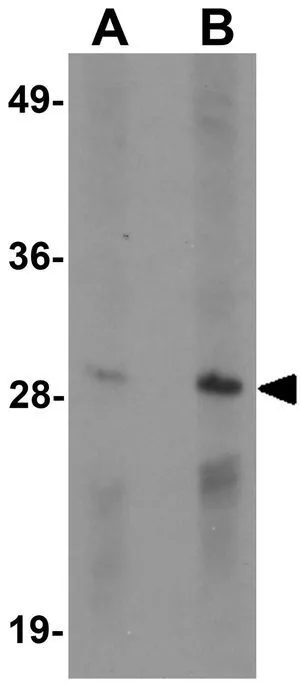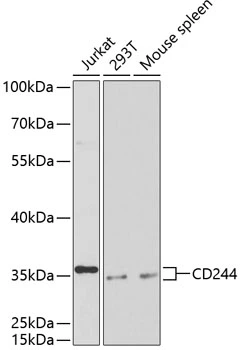
WB analysis of Daudi cell lysate using GTX17115 CD244 antibody. Working concentration : (A) 1 and (B) 2 microg/ml
CD244 antibody
GTX17115
ApplicationsImmunoFluorescence, Western Blot, ELISA, ImmunoCytoChemistry
Product group Antibodies
ReactivityHuman, Mouse, Rat
TargetCD244
Overview
- SupplierGeneTex
- Product NameCD244 antibody
- Delivery Days Customer9
- Application Supplier NoteWB: 1 - 2 microg/mL. ICC/IF: 20 microg/mL. *Optimal dilutions/concentrations should be determined by the researcher.Not tested in other applications.
- ApplicationsImmunoFluorescence, Western Blot, ELISA, ImmunoCytoChemistry
- CertificationResearch Use Only
- ClonalityPolyclonal
- Concentration1 mg/ml
- ConjugateUnconjugated
- Gene ID51744
- Target nameCD244
- Target descriptionCD244 molecule
- Target synonyms2B4, NAIL, NKR2B4, Nmrk, SLAMF4, natural killer cell receptor 2B4, CD244 molecule, natural killer cell receptor 2B4, NK cell activation inducing ligand NAIL, NK cell activation-inducing ligand, NK cell type I receptor protein 2B4, SLAM family member 4, h2B4, signaling lymphocytic activation molecule 4
- HostRabbit
- IsotypeIgG
- Protein IDQ9BZW8
- Protein NameNatural killer cell receptor 2B4
- Scientific DescriptionThis gene encodes a cell surface receptor expressed on natural killer (NK) cells (and some T cells) that mediate non-major histocompatibility complex (MHC) restricted killing. The interaction between NK-cell and target cells via this receptor is thought to modulate NK-cell cytolytic activity. Alternatively spliced transcript variants encoding different isoforms have been found for this gene.[provided by RefSeq, Oct 2009]
- ReactivityHuman, Mouse, Rat
- Storage Instruction-20°C or -80°C,2°C to 8°C
- UNSPSC12352203





![anti-CD244 [2B4] (human), mAb (ANC244.8/8F7)](https://adipogen.com/pub/media/catalog/product/a/n/anc-259-020-facs-web250_1.png)


